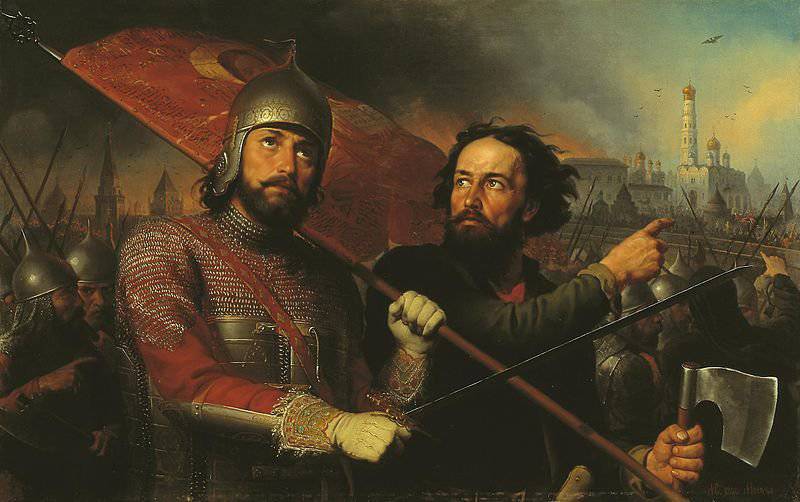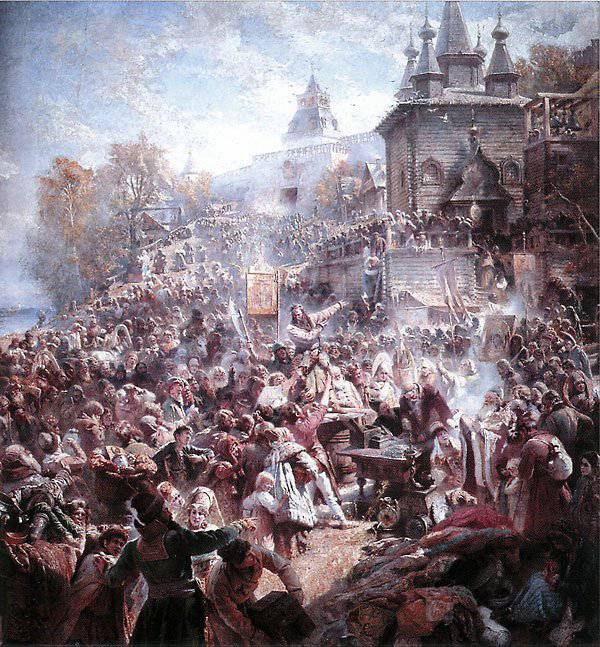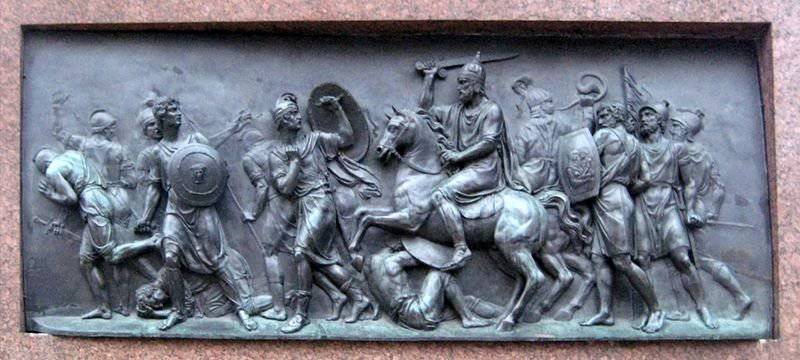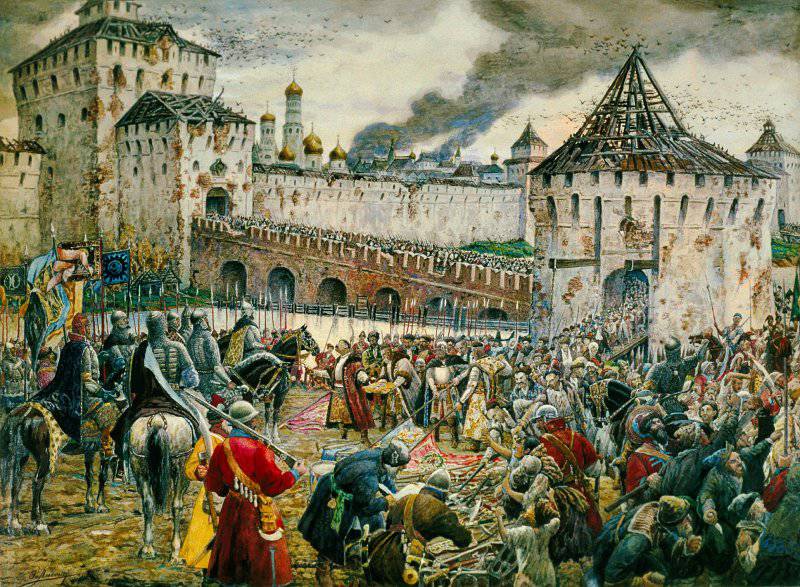Time of Troubles and the Cossacks. 4 part

We want to help the Moscow state, so don’t regret our property, don’t regret anything, sell yards, lay wives and children, and beat anyone to defend the true Orthodox faith and have been our boss.
Kuzma Minin
In September 1611, the formation of the Second Militia began in Nizhny Novgorod. It consisted of citizens and peasants of the central and northern regions of the Russian state, supported him and the city of the Volga region. Kuzma Minich Zakharyev Sukhorukiy (Zemstvo headman of Nizhny Novgorod, was in charge of the “rear” questions) and Prince Dmitry Pozharsky, he was in charge of the army, he was treated in the Nizhny Novgorod estate (chosen military leader).
Minin proved himself as a skillful organizer, and very tough if necessary. So, he carried out an assessment of the property of the population of Nizhny Novgorod and determined the part that should go to the needs of the troops. By decision of the headman, the militia was given a "third money," that is, a third of the property, or, in some cases, one-fifth. People who did not want to allocate the required amount without understanding the need for a “common cause” were transferred to the serfs, and their property was completely confiscated. By early April, 1612, near Yaroslavl, was already a powerful army.

Makovsky K.E. The Appeal of Minin.
The activities of the chieftain Ivan Zarutsky and his end
The ataman, after the collapse of the First Militia, completely “crushed” Prince Trubetskoy under him, although he was more generous. He endowed himself with patrimonies and estates, still trying to push "Tsar Dmitry Ivanovich" to the throne. But neither Kuzma Minin and Dmitry Pozharsky, nor Patriarch Hermogenes, who called the “prince” a “cursed Marinkin son,” nor the Cossacks “little pig,” was nice, supported his plans.
To strengthen his position, Zarutsky tried to capture Yaroslavl, but did not. Then he decided to support the third impostor - False Dmitry III, the Cossacks of March 2 1612 swore to him. He failed to take Moscow before the arrival of the Second Militia - the assault was repulsed with heavy losses. The authority of Zarutsky among the Cossacks fell, they were rumored about the good organization of the Second Militia, a good supply, payroll. Trubetskoy began negotiations on the unification of forces.
Then Zarutsky decided to eliminate Pozharsky - they sent "killers", Stenka and Pruning Cossacks to Yaroslavl. But the attempt was not succeeded when the prince’s guard, Cossack Roman, took the knife in the crowd on Pozharsky Square and tried to kill him. During the interrogation, the killers reported on the "customer". Pozharsky forgave them and released him to expose Zarutsky. In addition, the chieftain was caught in secret negotiations with hetman Jan Chodkiewicz.
Therefore, when in August 1612, the main forces of the Second Militia began to approach the capital, ataman Zarutsky took his supporters to Kolomna (half of the Cossacks went with him), and then to Mikhailov. Marina Mniszek with a “rogue” were with him.
Later, he did not recognize the decision of the Zemsky Sobor of 1613 to elect Mikhail Fedorovich Romanov to the throne and started a war against the new government, ruined several cities in the Tula Region. Against him sent an army led by commander Ivan Odoevsky. Voronezh had a two-day battle, after it Zarutsky passed Don and by the end of 1613, occupied Astrakhan. The ataman was supported by the Terekian Cossacks, he tried to raise the Donians, offering to go on a campaign against Samara and Kazan, but did not work out, only a few hundred supported him. Don Cossacks announced that the Cossacks did not want to start a new “theft”. As a result, he could not organize a new army for the war with Moscow.
In May, 1614, when serious forces were sent against Astrakhan, sent from Moscow and Terek voevod P.V. Golovin, Zarutsky fled to Yaik. There he was arrested after a fight and sent to Astrakhan and then to Moscow. In the capital, he was impaled, a “voronka” was hanged, and Marina Mnishek died in custody (according to another version, she was drowned or hung).
The third impostor ("Pskov thief")
On account of him, as in the first impostors, there is no reliable information, it is believed that it was Moscow clerk Matyushka (Matvey) Verevkin. At the beginning of 1611, he appeared in Novgorod and declared on the market that he was “the miraculously saved Tsarevich Dmitry,” but he was identified and driven out of the city in disgrace.
From there, the impostor fled to Ivangorod, and there 23 in March 1611 again declared himself “the surviving prince,” whom they could not kill in Kaluga. The inhabitants of Ivangorod were more trusting and celebrated the “miracle” for three days, rang the bells and fired from the cannons. False Dmitry III entered into negotiations with the Swedes, but they decided that they should not enter into an agreement with an impostor.
The impostor formed a small detachment around him and moved to Pskov - at the beginning of July 1611, his people settled in the vicinity of the city. Negotiations began with citizens on the conditions of recognition of his sovereign. Pskov initially were ready to recognize the "thief." But at that time the letters of Kuzma Minin and Dmitry Pozharsky arrived, the people were urged not to believe in them "neither Marinka with her son, nor the thief who stands near Pskov". In addition, the squad impostor did not differ discipline, robbed the neighborhood of the city. Having learned about the approach of a large Swedish-Novgorod detachment to Pskov, which was led by the Swedish general Evert Horn, the impostor 23 of August fled to Gdov.
The Swedes were unable to take Pskov, the townspeople beat off several assaults (in September-October, 1611 of the year). And the Swedish general Horn decided to lure an impostor to his side - he offered him to become governor of Pskov, but to abandon the claims to the throne of the Russian state in favor of the Swedish prince. The false Dmitry, continuing to play the role of the "legitimate king", rejected these proposals.
His forces increased, the impostor recognized several cities, and the False Dmitry was able to break into Ivan-city, although Gdov remained the main supporting base. In the autumn of 1611, the impostor detachments conducted military operations against the Swedes, but could not achieve great success. Pskov, seeing no help in the fight against the Swedes from the central regions of Russia, decided to recognize the impostor as the “tsar”. 4 December 1611, he drove into the city. In the winter of 1612, Cossack units of False Dmitry III carried out raids on Dorpat and Swedish Livonia.
In the spring of 1612, he was recognized as the “king” of Zarutsky, prince of Trubetskoy, southern and northern cities, Alatyr and Arzamas. But the third impostor was ruined by personal flaws. He led a lecherous life, squandered the Pskov treasury, imposed heavy taxes on the population, his servants seized women and girls in the streets and dragged them to the “king” for “fornication”. The Moscow Cossacks, disillusioned with the new “tsar,” left his squad, the Pskov themselves plotted against him. The impostor on the night of 18 in May 1612 fled the city, but was soon captured and taken to Pskov in chains. False Dmitry III was put in a cage and put on public shame, then taken to the capital. On the way the impostor was killed.
Battle for Moscow (22-24 of August, the new style of 1-3 of September, 1612 of the year)
The second militia was inferior in its military power to the First, it had 7-8 thousand people, but surpassed it in organization and supply. The basis of the troops were the Cossack horse and foot sony (up to 4 thousand) and 1 thousand archers, the rest of the army - this is the nobility and peasant militia, the townspeople. Part of the troops — peasants, tradesmen, part of the serving Cossacks — were poorly armed. There was hope for the support of the remnant of the First Militia - the detachment of Prince Dmitry Trubetskoy, there were about 2,5 thousand people in it. Before the battle, the troops of the princes Pozharsky and Trubetskoy brought mutual vows of loyalty.
Polish forces were more powerful: the Kremlin garrison was about 3-3,5 thousand people and the corps of the Lithuanian hetman Chodkiewicz in 12-15 thousand people. The Polish army was led by more experienced commanders. His weakness was the small infantry.
The command of the militia, given the diversity of their troops, from professional soldiers to peasants and townspeople who did not have good weapons, experience of war, decided to defend. Prince D. Pozharsky knew that the hetman was advancing from the Novodevichy Convent along the Smolensk road, and therefore placed the main forces directly in the path of the enemy’s corps. The militia positions were adjacent to the walls of the White City and were located on the earthen wall, which dominated the area. Prince Vasily Turenin led the left flank, his position was adjacent to the Moscow River at the Chertolsky Gate and the Alekseevskaya Tower. The defense of the right flank was led by voivods Mikhail Dmitriev and Fyodor Levashov, their detachment standing at Peter’s Gate. A detachment of Prince Lopaty-Pozharsky was located at the Tver Gate. The main forces under the command of Prince Pozharsky, Minin and Prince Khovansky were located at the Arbat Gate. The Cossacks of Prince Trubetskoy were supposed to protect Zamoskvorechye and stationed on the Vorontsov field and at the Yauza gates. Their squad was reinforced by several hundred of the main forces.
On the morning of August 22, the forces of Khodkevich crossed the Moscow River at the Novodevichy Convent. Getman planned to break into the city through the Arbat and Chertol gates and met on his way the fortified camp Pozharsky. The garrison made a sally to the hetman's troops - from the side of the Chertol gates, the Alekseevskaya tower and the Water gates, he was supported by artillery from the walls with fire, but he was smashed and driven back to the fortress. The battle with Chodkiewicz’s army went from the first to the seventh hour of the day. The hetman, seeing that the cavalry could not break through, led the infantry into battle - Hungarian, German mercenaries and other forces. The left Russian flank faltered, the situation was very difficult.
Fractures in the battle brought hundreds of Cossacks from the troops of Trubetskoy. The prince was inactive while the battle was on. As a result, five hundred, which were allocated to help Trubetskoy, and four atamans with their hundreds (about a thousand people) crossed the river and hit the hetman’s army on the flank, the Poles did not stand up and retreated.
Lithuanian hetman took the army to Poklonnaya Hill. On the night of August 23, a detachment of hundreds of 6 because of the betrayal of the nobleman G. Orlov (he was promised to give Pozharsky's estate) broke through to the Kremlin through Zamoskvorechye. At the same time, Polish troops captured one of the fortifications (St. George's Ostrozhek).
Chodkiewicz regrouped his forces and decided to break through from the south through Zamoskvorechye. Here, an earthen rampart with remains of wooden fortifications covered the road, it was occupied by the Yaroslavl militia, the mounted cavalry hundreds of the Second militia and some hundreds of Cossacks of Prince Trubetskoy moved in front of the ramparts. Behind the shaft, there was a well-fortified Clementyevsky burg (it was to be defended by the main forces of Trubetskoy), and the other bail — Georgievsky — was in the hands of the Lithuanian hetman.
24 August the Poles went on the attack, the left flank was headed by the hetman himself and fought "like a lion". In the center came the Cossacks Alexander Zborovsky, the regiment of Nevyarovsky and Hungarian mercenaries, on the right flank - the Zaporozhye Cossacks Ataman Shirai (Shiryay).
5 hours hundreds of the Second militia held back the onslaught, then broke down and began to retreat. In addition, the garrison of the city was struck from the rear and, together with the Cossacks of Zborowski and the Hungarians, captured the Clementyevsky jail. Pozharsky personally tried to stop the flight of the noble cavalry, but could not, she crossed over to the other side of the Moscow River.
Chodkiewicz decided to take advantage of the success and to transfer carts with food and ammunition to the fortress. But the Cossacks, knocked out of the Klimentievsk fortress, received help, counterattacked. The Polish wagon train was cut and partly captured. After that there was a pause, Khodkiewicz withdrew heavily battered forces. There was a shortage of infantry, which was needed to fight in an area uncomfortable for cavalry action.. As a result, when the militia forces launched an offensive against the camp of the Poles and the ramparts of the Earthen city, which the Poles now defended, the hetman's army, which suffered heavy losses in the morning, broke down and retreated. 25 August the remaining forces of the hetman made in the direction of Mozhaisk and further to the Russian-Polish border.
It was a victory that predetermined the outcome of the siege - the garrison did not receive food, ammunition, reinforcements, suffered heavy losses in two sorties.

The liberation of the capital
Detachments of Colonels Strus and Budila, traitors-boyars with their families, settled in China-town and the Kremlin. The future Russian sovereign, Mikhail Romanov, with his mother, nun Martha, was in the Kremlin and to whom little is known.
The besieged began hunger, they ate all the horses, dogs, cats, ravens. Pozharsky, knowing about their misfortune, at the end of September 1612 offered the conditions for an honorary surrender, guaranteeing not only life, but also free care, with banners and weapons, but without looted treasures. The Poles proudly refused, and even swore.
Hunger has reached a terrible stage: began to dig up the corpses and eat them, ate all the prisoners, then the walking girls. They killed and ate the sick, the weak, caught people on the street, some even killed their relatives, described a case in which one Polish officer ate his sons and another mother ate. Moreover, the Poles even salted human flesh, made stocks.
October 22 Russian troops captured China Town. It was no longer possible to defend, on October 26 (November 5) the remnants of the garrison surrendered and left the Kremlin. Budila and his squad hit the camp of Dmitry Pozharsky, and he was able to save his life, everyone remained alive. Later they were exiled to Nizhny Novgorod. I am struck with the regiment and came to the Cossacks of Trubetskoy, and they did not stand on ceremony with the enemy who had lost human appearance, they exterminated all Poles.
Feat garrison Volokolamsk
The liberation of Moscow happened quite in time, King Sigismund went with the army to the rescue of the garrison. In Vyazma, he connected with the units of Hetman Chodkiewicz. The Polish king sent an embassy, offering to put Vladislav on the kingdom, but the Zemstvo leadership rejected his claims.
A new march on Moscow tore off the garrison of a small Volokolamsk fortress. Voivode Karamyshev, seeing a huge difference in power, decided to capitulate. But Don stanitsa Atamans Nelyub Markov and Ivan Yepanchin removed him from command and took the fight.
The garrison repulsed three assaults, the Cossacks made a sortie, captured several guns. Winter was coming, and on November 27 the Polish king led the army away. Volokolamsk saved the Russian state from a new bloody invasion.
The expulsion of the Poles from the Kremlin. E. Lissner.

Information